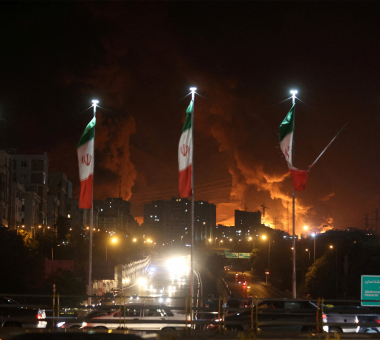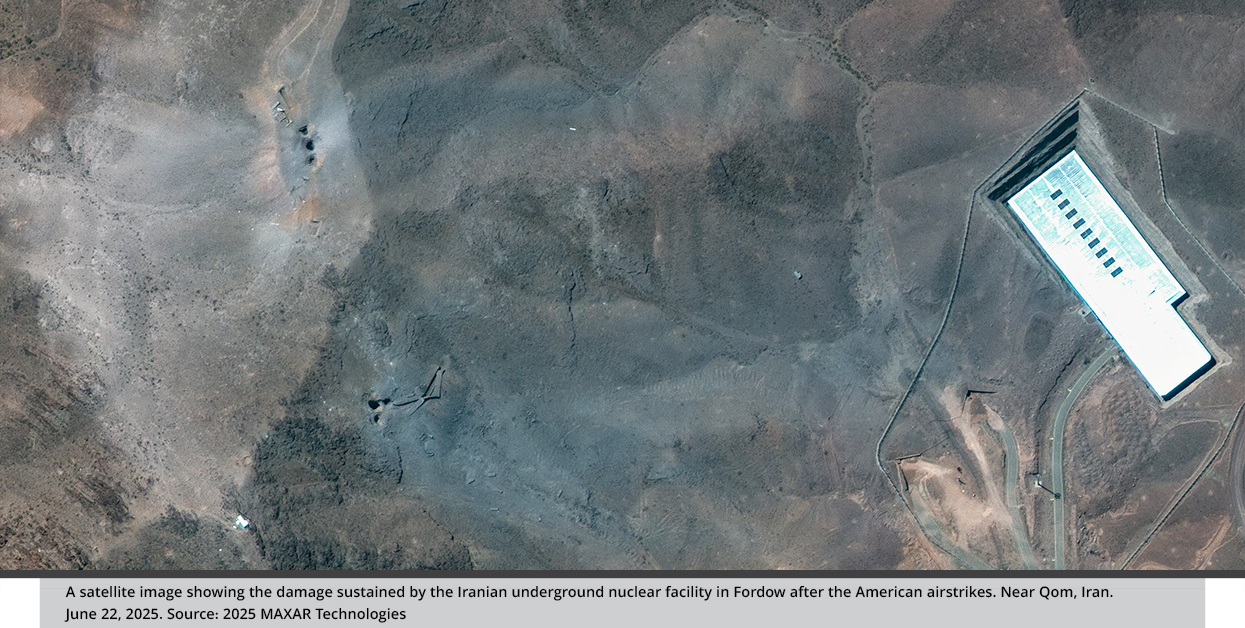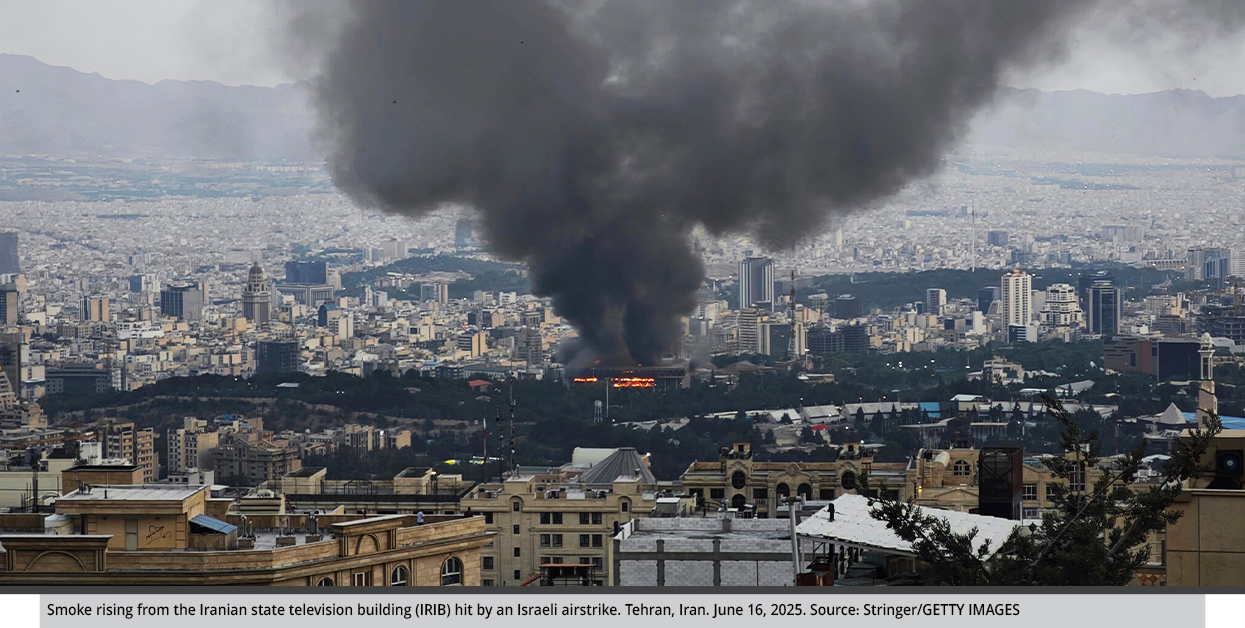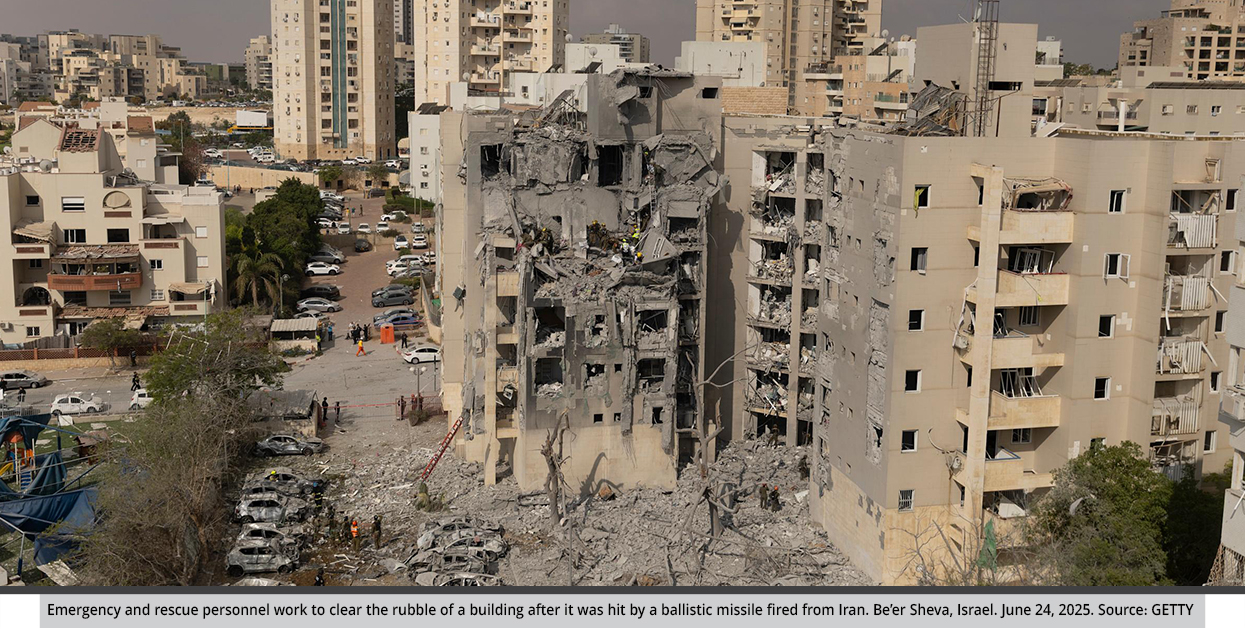Scenarios of the Confrontation between Israel and Iran after the Ceasefire
The ceasefire agreement between Israel and Iran, following the unprecedented confrontation, raises questions about the fate of the agreement and the scenarios for its Sustainability, especially given that both sides have adopted conflicting narratives regarding the objectives of the confrontation and the extent to which they were achieved. Although direct military operations have ceased, the agreement lacks the foundations necessary for its stabilization and continuity. It does not end the core hostility between the two sides but rather leads to three pivotal scenarios, the future balance of which will be shaped by several factors.
by STRATEGIECS Team
- Release Date – Jun 25, 2025

U.S. President Donald Trump’s June 24 announcement of a ceasefire between Israel and Iran came 12 days after the launch of Israeli strikes on Iran’s military capabilities, just two days after American attacks on key Iranian nuclear facilities, and only hours after Iran’s retaliation targeting the U.S. Al-Udeid Air Base in Qatar. This sudden and swift announcement raises pressing questions about the details of the ceasefire agreement, its chances of holding, and the possible scenarios that may unfold in the coming phase.
Diverging Narratives and Assessments of “Victory”
Following Trump’s announcement of a ceasefire, both Iran and Israel began presenting their divergent narratives regarding the recent military confrontation. From Israel’s perspective, which considers itself to have achieved strategic gains, Prime Minister Benjamin Netanyahu stated that the strikes targeting Iran’s capabilities would lead to a new Middle East in which Iran would no longer play an influential role, following the dismantling of its networks of influence and the destruction of its deterrent capacities.
On the ground, Israeli figures indicate an unprecedented level of operational achievement: more than 1,480 military and security targets were struck, including command and control centers, missile and nuclear facilities. More than 25 senior commanders of the Islamic Revolutionary Guard Corps, as well as individuals close to Iranian Supreme Leader Ali Khamenei, were assassinated, along with more than 15 nuclear scientists involved in uranium enrichment projects. Additionally, roughly 260 missile launch platforms were either destroyed or disabled. The U.S. strike also inflicted significant damage on Iran’s nuclear infrastructure, particularly at key sites in Fordow, Natanz, and Isfahan.

More importantly for Israel, its central objective of breaking the Iranian encirclement was achieved. The northern front, represented by Hezbollah in Lebanon and Syria, which had served as a strategic operational arena for Iran’s proxies, was neutralized. In addition, the interconnected fronts managed by Iran’s “Unification of the Arenas” doctrine were fragmented. These fronts had been mobilized to support Palestinian factions in the Gaza Strip, but were disrupted following the neutralization of armed groups in Iraq, the ceasefire agreement with Hezbollah, and regime change in Syria.
These developments forced Iran to respond through isolated actions, which in turn weakened coordination among its fronts and diminished their effectiveness in confronting Israeli targets.
In contrast, Tehran adopted a narrative that glorified the state of victory despite the evident losses. In its official discourse, Iran portrayed its endurance in the face of the large-scale Israeli and American assault, and its ability to respond as a victory in itself. This response was embodied in the launch of approximately 550 ballistic missiles and 1,000 drones toward Israel, resulting in the deaths of 28 Israelis, injuries to more than 1,300 others, and the destruction of dozens of civilian and military sites.
Among the most notable targets hit were the Weizmann Institute of Science and the Haifa oil refinery. The financial toll of war on Israel was estimated at a daily cost ranging between $725 million and $1 billion.
From the Iranian perspective, the political system endured, and its leadership structure remained functional despite the targeted assassinations of senior figures. Iran also retained key pillars of its strategic deterrence, including the core of its nuclear program and its arsenal of missiles and drones, both of which remain capable of being developed and replenished.
Throughout the confrontation, Iran continued to launch missile strikes. It even introduced new weaponry, most notably the Fattah-1, the latest missile in its arsenal, designed for deep penetration and capable of bypassing Israeli air defense systems. Additionally, Iran deployed the multi-warhead Kheibar Shekan missile, which was used in the final strike on the city of Be’er Sheva just before the ceasefire took effect. That strike resulted in the death of seven Israelis and injuries to several others, marking Iran’s concluding response in the conflict.
Despite the contradiction between the two narratives, both sides exhibit internal inconsistencies that reveal the nature of the war as a deterrence operation rather than a decisive victory. Iran, which speaks of strategic resilience and retaining its deterrence capabilities, overlooks the systematic destruction of its missile infrastructure, its failure to prevent the American strike on its nuclear facilities, and the significant losses among its senior leadership.
Conversely, Israel accepted an unconditional ceasefire agreement despite its capacity to continue operations deep inside Iran, particularly in eastern and southern regions that had not yet been targeted. This Israeli retreat, despite its operational superiority and unprecedented infiltration into Iranian territory, reflects a limited political will to continue an open-ended confrontation with Tehran, especially under pressure from the U.S. and Trump’s insistence on enforcing the ceasefire.
Operational Foundations of the Ceasefire
The ceasefire between the two sides rests on key factors, primarily the desire of influential international and regional actors to end the war and avoid its escalating consequences, serving as a central pillar in supporting the truce.
At the international level, the United States stands out. Despite its direct involvement in striking Iran’s nuclear facilities, Washington, in an effort to contain the escalation, quickly called publicly for peace. Another notable actor is China, which views the continuation of the war as not serving its strategic interests. This may prompt Beijing to exert pressure on Tehran to adhere to the ceasefire and tone down its rhetoric against both the United States and Israel.
More broadly, European and regional countries view the ceasefire agreement as serving their direct interests, driven by a growing conviction that the continuation of the conflict threatens regional security and stability. European capitals have repeatedly expressed their rejection of a military solution and their preference for a negotiated path, emphasizing the need to contain the escalation. France, in particular, has adopted a clear stance in this regard.
At the regional level, Arab states and Turkey are acutely aware of the security and economic risks posed by the expansion of the conflict, especially given the geographical overlap and intertwined security dynamics in areas such as Jordan and the Gulf. Accordingly, these actors have regarded the consolidation of the ceasefire as essential to avoiding further chaos and heightened tensions in the region.
On the other hand, the recent confrontation represents an exception to the longstanding nature of hostility between the two sides, which has always been marked by their ability to avoid direct confrontation or military incursions into each other’s territories. Additionally, the exhaustion suffered by both parties has become a pressing factor toward de-escalation. Since October 2023, Israel has been engaged in continuous and complex military operations across a wide geographic area, straining its logistical and human capacities.
For its part, Iran has sustained significant losses in its leadership and military structures, while its defensive capabilities and nuclear program have been subjected to damaging strikes. In recent days, risks threatening the stability of Iran’s political system have increased, especially as Israeli strikes have expanded to target internal security forces and the Basij militia, in addition to direct threats to assassinate Khamenei. This has placed Tehran in a precarious defensive position, intensifying both internal and external pressures.
This context explains why neither country has officially declared a state of war, reflecting a mutual desire to retain the ability to manage escalation based on field developments and daily changes. Moreover, it has become evident to Israel how complex the continuation of the war—or the expansion of its objectives to include groundwork for regime change—has become. Netanyahu told Fox News on June 15 that Israeli military attacks on Iran could lead to regime change there.

The transition to genuine negotiations that address the core contentious issues between the two sides—chief among them Iran’s nuclear file—remains contingent upon the stability of the ceasefire. If the ceasefire holds and endures, it could pave the way for a return to the previous rules of engagement, which were characterized by the avoidance of full-scale confrontation. However, its collapse or delay signals a continued escalation and the risk of a prolonged direct conflict, undermining the prospects for a diplomatic solution.
Is the Ceasefire Sustainable?
Assessing the ceasefire requires considering the broader context of the decades-long Iranian-Israeli conflict, which cannot be reduced to the outcomes or understandings of the most recent direct confrontation. The ceasefire refers specifically to the halt of combat and direct military hostilities that began June 13—particularly within the primary theaters of conflict inside Iranian and Israeli territories. However, it does not necessarily signify the end of the state of hostility between the two countries.
Given the complex nature of the hostility between the two countries—with its multiple tools, actors, and arenas, as well as its intertwined and complicated issues—the agreement may not necessarily extend to indirect or covert hostilities between them. In practical terms, it returns both states to the rules of engagement that were in place prior to mid-June, which do not cover indirect hostilities such as attacks carried out by Iran’s proxies against Israel or Israeli intelligence and cyber operations targeting Iran.
From a technical standpoint, the ceasefire agreement lacks the fundamental components necessary to ensure its sustainability. Chief among these are the presence of a neutral mediator, a written agreement outlining the commitments of both parties, mechanisms for monitoring violations by either side, and the involvement of international and regional actors to guarantee the enforcement of the agreement and oversee the implementation of its terms—all while exerting direct pressure to ensure compliance. In addition, supportive resolutions from the UN Security Council are also essential.
In the current context, the agreement lacks many of the essential conditions for a successful ceasefire. The deal between the three parties was reached orally, with the United States acting as the main mediator, despite its active and direct involvement in the attacks, which weakened its position as a neutral and acceptable mediator in the eyes of Iran. The agreement appears to have been reached hastily, under diplomatic and military pressure that primarily served Washington’s strategic priorities rather than ensuring a sustainable de-escalation.
Furthermore, acceptance of the agreement was limited to the highest political levels in both countries, without the activation of institutional mechanisms capable of embedding it within the security and military decision-making structures. This has led to poor internal coordination and a diminished practical commitment to the terms of the agreement.
The fragility of the agreement was clearly demonstrated when several Iranian officials—among them Foreign Minister Abbas Araghchi—denied any knowledge of its existence, exposing internal coordination flaws and a lack of clarity regarding how the agreement was reached. The ceasefire lasted only a few hours before both sides violated it: Israel reported the launch of two missiles from within Iranian territory and responded immediately with airstrikes accompanied by escalating rhetoric. Amid this escalation, Trump—the mediator and sole guarantor at this stage—intervened by calling on Israel to withdraw its pilots, in an attempt to contain the crisis and prevent it from escalating into a full-scale confrontation.
The agreement came as a result of both American and international pressures on one side and battlefield realities and their repercussions on the other. However, it does not guarantee a permanent settlement but rather represents a temporary truce governed by security and military factors that could lead to its violation at any time. Three potential scenarios can be envisioned: a return to the previous rules of engagement, the collapse of the agreement, or the advancement of placing the contentious issues on the negotiating table.
Scenario One: Maintaining Calm and Returning to Previous Rules of Engagement
This scenario assumes the ceasefire will hold direct confrontation between the two states will come to an end. Given the continued sources of tension between them, it is likely that the conflict will revert to the previous rules of engagement, characterized by indirect confrontation, covert operations, and intelligence warfare. Within this framework, Israel may resume carrying out assassinations and cyber-attacks without officially claiming responsibility, while Iran may return to exerting pressure through its proxies, foremost among them the Houthis, who continue their operations against Israel. This would allow Iran to prolong the conflict while maintaining a plausible degree of deniability.
This scenario is grounded in an Israeli perspective that emphasizes the need to maintain close monitoring of Iran’s nuclear developments, especially in light of intelligence assessments suggesting that the U.S. strikes on nuclear facilities had limited impact. These assessments also highlight Iran’s growing expertise in ballistic missile technology, which may pose a future strategic threat, necessitating early efforts to undermine it. For its part, Iran may seek to reactivate its regional proxies through unconventional means and reorganize its regional presence and foreign policy priorities.
Scenario Two: Resumption of Limited Direct Confrontations
This scenario assumes a shift in the nature of the conflict between the two states toward a pattern of direct attacks that provoke retaliatory responses, within the scope of the capabilities demonstrated by both sides during the recent confrontation. Israel showcased its ability to carry out aerial operations within Iranian airspace, while Iran revealed a missile system capable of penetrating Israel’s advanced air defense systems. Notably, the recent confrontation was preceded by a series of controlled direct attacks, including Iran’s strikes on April 14, 2024, followed by a large-scale missile attack involving around 180 missiles in early October of the same year.

This scenario is based on the premise that the ceasefire agreement primarily aims to curb the escalation that began in mid-June, without establishing a broader framework to prevent its recurrence, given the underlying factors embedded in the nature of hostility between the two states. As a result, the ceasefire is limited to regulating recent military activities only, without addressing the future of their relationship. With tensions between the two sides having recently escalated into direct confrontation, similar clashes are expected to recur under the current circumstances.
This scenario also relies on the possibility that Israel will seek to maintain its aerial presence over Iranian airspace and preserve its operational freedom to carry out preventive or preemptive strikes—similar to the operational freedom it maintains against Hezbollah in Lebanon despite the ceasefire agreement signed on November 27, 2024, and even in the presence of robust mechanisms for monitoring the ceasefire.
Scenario Three: Temporary De-escalation as a Prelude to a Broader Negotiating Framework
This scenario assumes that the Israeli and U.S. strikes may push Iran to engage in negotiations with the United States more seriously and with less rigidity, in light of the political leadership’s new priorities of preserving the regime rather than defending the military and nuclear capabilities that had previously formed the spearhead of its negotiation strategy. The scenario also assumes that the United States views Iran’s current position as an opportunity to reopen talks over what remains of its nuclear assets, particularly its stockpile of highly enriched uranium. This could potentially lead to Iran offering greater nuclear concessions than in the past in exchange for the lifting of economic sanctions.
However, this scenario is unlikely to unfold in isolation from the first and second scenarios, given the reliance of both the United States and Israel on the use of force as a means to achieve peace. Notably, the Israeli strikes in mid-June took place just two days before the sixth round of semi-direct negotiations, while the U.S. strike occurred one day after Iranian-European talks.
This highlights that military actions are not necessarily separate from diplomatic tracks. Rather, they have increasingly been employed as tools of negotiation and pressure, especially if intelligence assessments confirm the resilience of Iran’s nuclear program and its limited vulnerability to recent strikes. This situation calls for timely intervention to prevent a return to the status quo that existed prior to the developments of June 2025.
Finally, the three scenarios indicate that the ceasefire does not mark a definitive end to the hostility or a comprehensive conclusion to the military confrontation between the two sides in all its forms. Between shadow conflict, potential collapse, and negotiations that may involve complications, the outcome remains contingent on a set of key factors: most notably, the role of the United States as a mediator and driving force behind the ceasefire, as well as the political will and operational capabilities of both parties of the conflict. Lasting stability will not be achieved without redefining the new rules of engagement and establishing clear mechanisms for reverting to them.

STRATEGIECS Team
Policy Analysis Team
 العربية
العربية